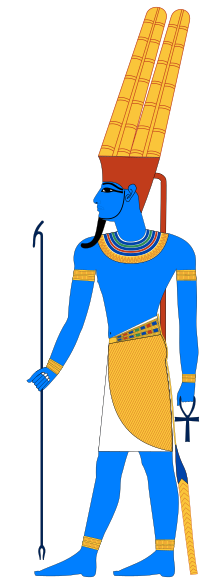
Back Amoen Afrikaans Amun ALS አሙን Amharic آمون Arabic امون ARZ Amón AST Амун AV Amon Azerbaijani Амон Byelorussian Амон Bulgarian
| Amun | |||||
|---|---|---|---|---|---|
 After the Amarna period, Amun was painted with blue skin, symbolizing his association with air and primeval creation. Amun was also depicted in a wide variety of other forms. | |||||
| Name in hieroglyphs |
| ||||
| Major cult center | Thebes, Hermopolis, (as a member of the Ogdoad) | ||||
| Symbol | two vertical plumes, the ram-headed Sphinx (Criosphinx) | ||||
| Consort | |||||
| Offspring | Khonsu | ||||
| Equivalents | |||||
| Greek equivalent | Zeus | ||||
| Part of a series on |
| Ancient Egyptian religion |
|---|
 |
|
|
Amun (US: /ˈɑːmən/; also Amon, Ammon, Amana, Amen; Ancient Egyptian: jmn, reconstructed as /jaˈmaːnuw/ (Old Egyptian and early Middle Egyptian) → /ʔaˈmaːnəʔ/ (later Middle Egyptian) → /ʔaˈmoːn/ (Late Egyptian), Coptic: Ⲁⲙⲟⲩⲛ, romanized: Amoun; Greek Ἄμμων Ámmōn, Ἅμμων Hámmōn; Phoenician: 𐤀𐤌𐤍,[1] romanized: ʾmn) was a major ancient Egyptian deity who appears as a member of the Hermopolitan Ogdoad. Amun was attested from the Old Kingdom together with his wife Amunet. With the 11th Dynasty (c. 21st century BC), Amun rose to the position of patron deity of Thebes by replacing Montu.[2]
Initially possibly one of eight deities in the Hermapolite creation myth, his worship expands. After the rebellion of Thebes against the Hyksos and with the rule of Ahmose I (16th century BC), Amun acquired national importance, expressed in his fusion with the Sun god, Ra, as Amun-Ra (alternatively spelled Amon-Ra or Amun-Re). On his own, he was also thought to be the king of the gods.[3]
Amun-Ra retained chief importance in the Egyptian pantheon throughout the New Kingdom (with the exception of the "Atenist heresy" under Akhenaten). Amun-Ra in this period (16th to 11th centuries BC) held the position of transcendental, self-created[4] creator deity "par excellence"; he was the champion of the poor or troubled and central to personal piety.[5] With Osiris, Amun-Ra is the most widely recorded of the Egyptian gods.[5] Ra's name simply means "sun." Like most gods in Egyptian mythologies, gods had multiple names; his additional names were Re, Amun-Re, Khepri, Ra-Horakhty, and Atum.[6]
As the chief deity of the Egyptian Empire, Amun-Ra also came to be worshipped outside Egypt, according to the testimony of ancient Greek historiographers in Libya and Nubia. As Zeus Ammon and Jupiter Ammon, he came to be identified with Zeus in Greece and Jupiter in Rome.
- ^ RÉS 367
- ^ David Warburton, Architecture, Power, and Religion: Hatshepsut, Amun and Karnak in Context, 2012, p. 211 ISBN 9783643902351
- ^ Stark, Rodney (2007). Discovering God: The Origins of the Great Religions and the Evolution of Belief (1st ed.). New York: HarperOne. p. 405. ISBN 978-0-06-117389-9.
- ^ Dick, Michael Brennan (1999). Born in heaven, made on earth: the making of the cult image in the ancient Near East. Warsaw, Indiana: Eisenbrauns. p. 184. ISBN 1575060248.
- ^ a b Arieh Tobin, Vincent (2003). Redford, Donald B. (ed.). Oxford Guide: The Essential Guide to Egyptian Mythology. Berkley Books. p. 20. ISBN 0-425-19096-X.
- ^ "Ra". Mythopedia. Retrieved 2024-05-07.